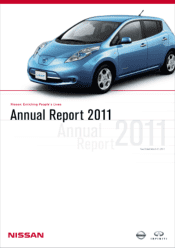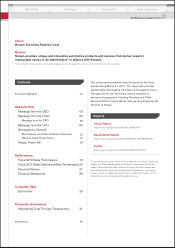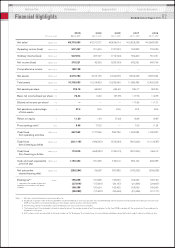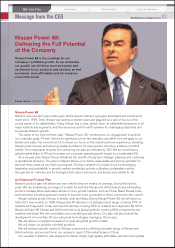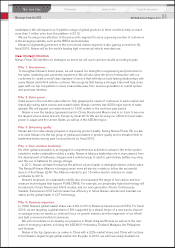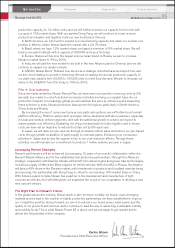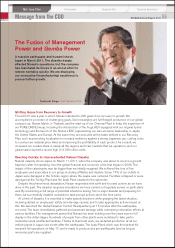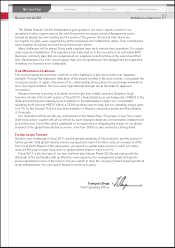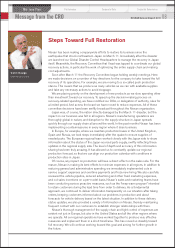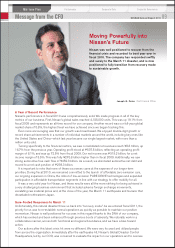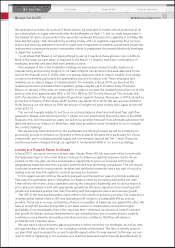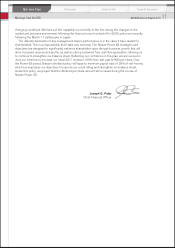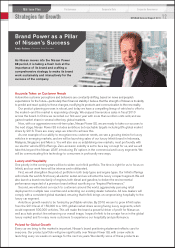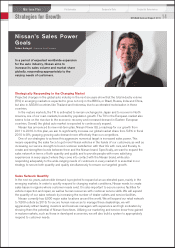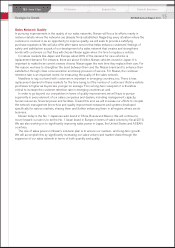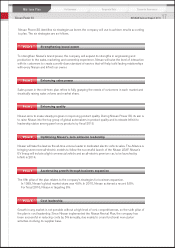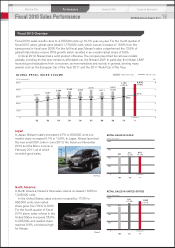Nissan 2011 Annual Report Download - page 11
Download and view the complete annual report
Please find page 11 of the 2011 Nissan annual report below. You can navigate through the pages in the report by either clicking on the pages listed below, or by using the keyword search tool below to find specific information within the annual report.
the restoration activities. As a result of these actions, we were able to restart vehicle production at all
our vehicle plants in Japan one month after the earthquake, on April 11, and our Iwaki engine plant—
the hardest hit due to its proximity to the epicenter—achieved full production capability in mid-May. We
have tackled supply chain disruptions by working closely with our suppliers, supporting their recovery
actions and securing alternative sources for parts and components as needed, and we have proactively
implemented companywide power conservation efforts in preparation for potential electricity shortages
in Japan this summer.
I must stress that Nissan is not playing things by ear as it reacts to these all-new crisis conditions.
Most of the steps we have taken in response to the March 11 disaster have been continuations of
strategies, priorities and plans that were already in place.
One example of this is the localization strategy we have been pursuing to better balance our
manufacturing and sourcing footprint to our sales footprint. Our actions in this area date back to the
start of the financial crisis in 2008, when our primary objectives were to reduce volatility from foreign
currency movements, particularly the appreciating yen, and to reduce cost. These strategies and
initiatives are in various stages of implementation. For example, in fiscal 2010, we launched the
localized production and sales of the V-platform global compact car in Thailand, India, China and
Mexico. In January of this year, we made public our plan to increase the localized production mix of fully
built-up units from approximately 69% in 2010 to 85% by 2015 in the Americas. This includes the
shift of production of the next generation Rogue from Japan to Smyrna, Tennessee, in 2013, as well as
production in Smyrna of the Nissan LEAF and the new Infiniti JX in 2012. We also announced that in
North America, we will reduce by 50% the amount of bought-out parts coming from Japan by the end
of fiscal 2013.
The second example relates to our focus on a strong balance sheet and sustained free cash flow
generation. Nissan went into the post-3/11 phase on more solid footing than at the time of the 2008
financial crisis. Over the past two years, our actions to prioritize free cash flow, eliminate automotive net
debt and reduce our reliance on short-term debt have provided a sound foundation for us to navigate
the current challenge.
We are learning fresh lessons from the earthquake, too. Moving forward we will be modifying our
purchasing process to enhance our business continuity plan at the parts level, particularly for critical
components, and to mitigate potential supply risk concentration beyond the Tier 1 level. These are
evolutionary kaizen changes, though, as opposed to fundamental shifts in our sourcing strategy.
Looking to a Powerful Future for Nissan
In fiscal 2011 we launch our new mid-term plan, Nissan Power 88. My main task will be to work with
the leadership team to insure that Nissan continues to deliver exceptional business results. As we
embark on this new plan, we have a tremendous opportunity to grow our business both through
geographical expansion and from a product portfolio and new technology perspective. This will require
continued investment in new products, factories and distribution networks, and a key part of my job is
making sure we have the capital to continue growing our business.
In this regard, we will continue the actions pursued over the past two years to prioritize sustained
free cash flow generation and to strengthen our balance sheet by increasing automotive net cash.
These efforts will involve close cooperation among the company’s leadership and its various teams to
put in place a business model with appropriate operational efficiency objectives, thus ensuring profit
growth and sustained positive free cash flow along with the expected volume and revenue growth.
The “88” in the new business plan’s name refers to the results of achieving our plan. Our goals are to
increase global market share to 8% and operating profit margin to a sustainable 8% as soon as
possible. These are in no way contradictory; there is no question of balancing one against the other. We
have to accept the premise that growth in our sales volume or market share must lead to higher
profitability, if not immediately, then in the very near term—otherwise we should not invest to achieve
that growth. At Nissan, we have implemented a very disciplined process to ensure that we carefully
scrutinize our investments, proceeding only when we have confidence that they will enhance
profitability and corporate value.
We also have a robust business planning process in which we review our strategies, as well as risks
and opportunities, in the context of our changing business environment. This lets us identify areas in
our plans that need increased focus and to identify opportunities for improvement. In this way, we can
react to what is happening in our business on a real-time basis and respond quickly and effectively to
Message from the CFO
Mid-term Plan
Performance Corporate Data Corporate Governance
10
NISSAN Annual Report 2011

